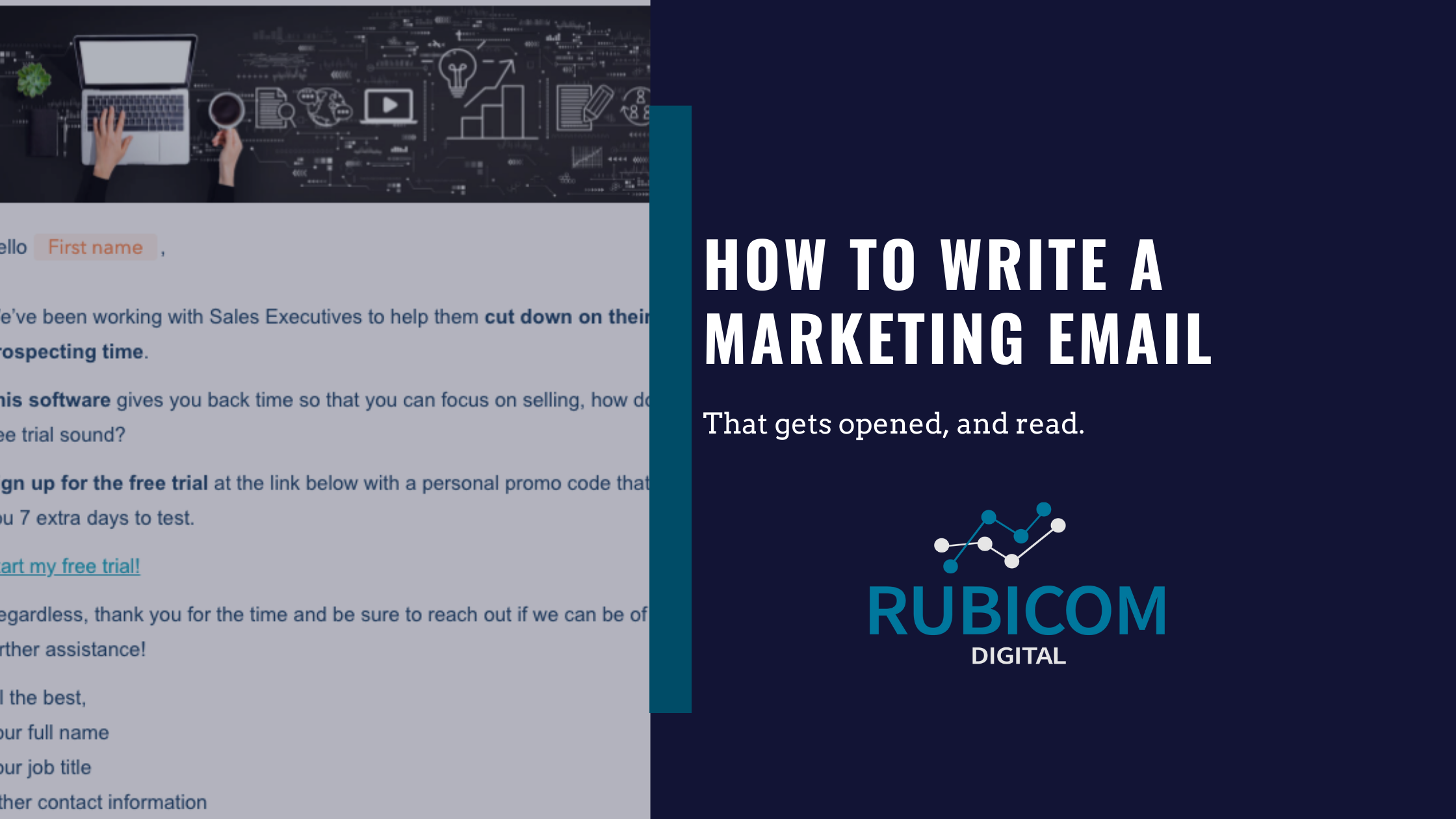Learning how to write a marketing email that gets opened is the first step in deploying an email marketing strategy that:
- Enhances visibility
- Inform
- Generate revenue
With 105 BILLION emails sent per day, email receivers are so inundated that emails are often overlooked.
The first step in accomplishing any of the three goals mentioned above is getting the email opened to begin with.
This post is going to discuss:
- Creating an enticing subject line
- Structuring your email
- Engaging your audience
Create an enticing subject line
The subject line is the first thing your target audience sees and can be the determinant factor as to whether or not your email gets opened. Here are some of the most common subject lines we see:
Bad
- <Following up>
- <Checking in>
- <Introduction>
- <Can we sync?>
- *Our personal favorite <Just Circling Back>
If you’re smiling while reading those subject lines, it’s because you probably see them daily, and you definitely don’t respond to them.
Better
Rather than the boring, ‘corporate speak’ subject lines, let’s try a new approach. Your subject line should immediately:
- Highlight the topic of the email
- Showcase the value of your correspondence
Here are some examples:
- <I’ll trade you coffee for a better understanding of your business-process pain points>
*This has an offer, and clearly shows that you’re seeking to better understand their pain in hopes of making their life easier.
- <Better marketing practices than Blockbuster>
*This subject line shows the value of creating better marketing practices. After all, no one wants to be associated with a company that went under.
- <Are you no longer interested in IT support for your staff?>
*This subject is a much better version of ‘just circling back’. The follow-up spells out the initial topic (IT support), and asks if it’s still an interest.
Create a subject line that calls out the value and offer so that your reader isn’t guessing what you’re looking to accomplish.
According to Campaign Monitor, the avg. email open rate is only 18%; The subject line is just the first part.
Structuring your email
There are three critical pieces after the subject line that need to be included in your email structure:
- The value
- The offer
- The next step
The Value
The reason you’re reaching out to your audience is to provide value. If you don’t have a value-add, then you don’t have an impactful email to write. Examples:
- “Here’s an article we thought you would find helpful as it pertains to changes in X industry.”
- “We’ve been working with Sales Executives to help them cut down on their prospecting time.”
- “By spending less time with CRM data entry, you’ll have more time to focus on your core business.”
The above examples all have a value-add to the reader; Whether it be informative or simply letting the receiver know how you’ve helped other organizations complete X goal, it should be enticing enough to bring them down to the next part of your email.
The Offer
You introduced your email with the value that can be offered, and you’ll follow it up with the offer itself. Here are some examples:
- “Click here for the article that breaks down how these changes will impact you and how we can help ensure you’re ready.”
- “This software gives you back time so that you can focus on selling, how does a free trial sound?”
- “This automated platform helps you cut down on mundane tasks and increase your productivity.”
Where the value informs your reader on what they’re getting, the offer tells them how they’re getting it (article with information, software, automated platform). Now if they’re really intrigued by both the value and offer, they’ll continue reading down to the inevitable last part.
The Next Step
Great, the value and offer are intriguing, so what’s next? You must provide a clear path that shows the reader how to move forward if they’re interested. Here’s how:
- “If you found the article appealing and are looking for some help getting ready for the next step, schedule a meeting with me in the link below.”
- “Sign up for the free trial at the link below with a personal promo code that gives you 7 extra days to test.”
- “Can I trade you coffee next Tuesday to further dive into the offering?”
You’ve now clearly outlined what comes next to your target audience, and how to go about accomplishing that next step.
*You’ll notice the last example includes a second offer by trading them coffee for a meeting, we’ll call this the 2 for 1 special.*
Now, take 1 sentence from each the value, the offer, and the next step and plug it into an email that can look a little something like this. (Bonus points for an appealing image)
Keep in mind this is a basic example of what the email will look like and how it should be structured. Simple, to the point, with a ‘less is more’ approach.
Now that you have a better understanding on how to structure the email, let’s add some flavor to it that will engage the audience a bit more.
Engaging your audience
It’s not enough to just simply get your email opened; You want it to get read. Enter the aspect of personalization in digital marketing to enhance your emails even further.
There are companies out there that will produce mass email sending lists for you, but that’s not an effective long-term strategy. You’ll hurt email reputation, and ultimately become known for your spammy emails.
Email marketing in the 2020’s requires much more due diligence on your target audience. Most marketers are turned off by this because it’s going to take a lot more time and effort to build your lists, but it’s worth it.
There are two easy ways to incorporate personalization within your marketing emails.
- Incorporate real-life events
- Research your target audiences’ interests
Incorporating real-life events is the practice of speaking to your target audience about things that are currently happening in the real world.
Direct approach:
A direct approach specifically calls out the real-life event you’re talking about. Whether it be a new show released on Netflix, or a big sporting event, you’re explicitly calling it out.
Is the Super Bowl coming up? How about that halftime show?
A simple subject line of “X product will be more entertaining than the halftime show” will certainly capture a reader’s attention more than “Hey, just following up”.
Indirect approach:
One of our favorite examples of this was performed by Calm in the later half of 2020 with an election approaching and a pandemic surging.
Knowing that their audience might be more stressed out than usual, Calm ramped up their TV ads with the soothing sound of rain. No sales pitches, just silence. Here’s an example of what those ads looked like. It’s worth noting that this example is from 2019, so they’ve frequently run the ads before, but ramped them up in the appropriate time that made their audience feel that they were speaking to them without actually saying anything.
Now this was a TV ad, and we’re talking about how to write a marketing email here. Nonetheless, the concept and messaging still applies whether you’re trying to understand how to write a marketing email or just appeal to your audience.
The last piece to enhance your emails is researching your target audience and better understanding what they’re interested in.
By adding personalization variables within your email marketing platform/lists, you’ll be able to send out emails that highlight:
- Birthdays
- Favorite holidays
- News regarding their alma mater
- Local, popular restaurants
- Heck, even their favorite beer
Now, we’re not telling you to hire a private investigator to learn everything you can about them, but social media has made the world a much smaller place and enables you to easily access information in order to better serve your target audience.
For example, at the bare minimum, LinkedIn makes it easy to see where anyone went to college! Incorporate a local restaurant from their college days into your email and watch your email engagement soar.
After all, people want to talk to people, not robots. Personalization greatly helps in this area.
How To Write a Marketing Email That Gets Opened and Read
- Create an enticing subject line that captures their attention
- Structure the email in a way that’s easy to navigate. include
- A value
- An offer
- A next step
- Ensure the email is visually appealing
- Leverage the power of personalization
Let us know how you’re incorporating these practices and what your engagement has looked like after better understanding how to write a marketing email!

Gary McConnell Co-founded Rubicom Digital in 2019 with a goal of providing digital marketing consulting services in the B2B space.
Gary continues to serve as the Marketing Director of a Data Center-focused IT Provider, VirtuIT Systems.

